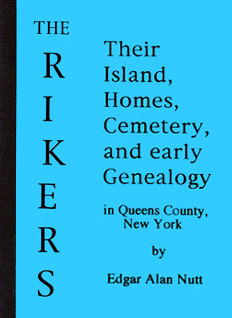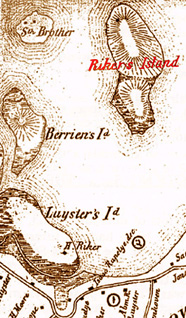|
[Author's note:]Throughout the genealogy several conventions will apply. When the name of a son is capitalized, that son will be the head of his own family unit
listed in the following generation. . . . . a number preceded
by the pound sign (#) indicates a particular burial plot or memorial in the Riker Cemetery
as identified in Chapter Four.
[Webmaster's note: In this web excerpts presentation, the births, baptisms, and marriages of sons whose names are capitalized will not usually be given in their fathers' own background sections. What data is given about a male descendant whose name has been capitalized will be given when he is discussed in his own background section as head of his own family unit. After the third generation, data excerpted will become increasingly selective.
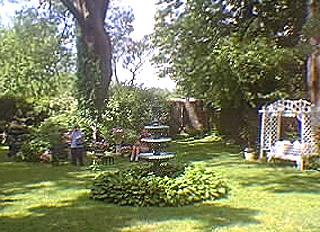 A view of part of Lent Riker Smith Homestead's beautifully decorated and landscaped grounds looking northerly toward the stockade fence. A view of part of Lent Riker Smith Homestead's beautifully decorated and landscaped grounds looking northerly toward the stockade fence.Photo by NYCHS during the June 5, 2005 tour given by Marion Smith to benefit the Queens Historical Society. Tour images do not appear in Edgar Alan Nutt's 2004 book and have been added to the web version by NYCHS. Click image to visit the Queens Historical Society web site.
|
|
In certain cases of female descendents and those male descendents whose names have NOT been capitalized, some background data with potential historical interest may be provided.]
FIRST GENERATION
ABRAHAM RYCKEN (RIJCKEN vanLENTí)
Born - Holland; circa 1615 (based upon reported age 74 at death).
Died - 1688.
Married - Grietie Hendrickse, doubtfully the daughter of Hendrick Harmensen who in 1638 settled a farm on Sanfordís Point, Flushing Bay. [She is presumed dead] by Jan. 9, 1688, since she was not named in Abrahamís will.
[Sons] RYCK ABRAMSEN LENT, Jacob 1, Jacob 2, Hendrick, JOHN (Jan), ABRAHAM, HENDRICK LENT.
[Daughters] Mary (Maritie) and Aletta (Aeltje).
Mary - born 1649; died after 1715; married as Marytje Abrahams April, 1669 to Sibout Harckszen Kranckheyt, son of Harck & Wyntie (Theunis); moved to Cortland Manor; 8 children.
Aletta - born 1653; married 1680 (or 1673) to Capt. John Harmanszen vanLennep; removed to
Cortland; 3 children.
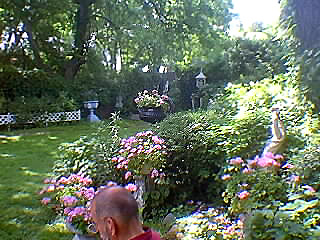 Another view of the Lent Riker Smith Homestead rear garden looking diagonally across it toward the Secret Garden entry gate. Another view of the Lent Riker Smith Homestead rear garden looking diagonally across it toward the Secret Garden entry gate.Photo by NYCHS during the June 5, 2005 tour given by Marion Smith to benefit the Queens Historical Society. Tour images do not appear in Edgar Alan Nutt's 2004 book and have been added to the web version by NYCHS. Click image to visit the Queens Historical Society web site.
|
|
Abraham came from Holland by 1638 and lived first in New Amsterdam, where
all the children were born, before obtaining land in Newtown and acquiring in a
1664 patent from Gov. Petrus Stuyvesant what became Rikerís Island, as detailed in an
earlier chapter.
Soon he was involved in a variety of property transactions, the first
of which was in 1638 for a Wallabout tract of land from the West India Company,
patented to him on Aug. 8, 1640, by Director-General William Kieft; this tract may
have been regranted in 1660 to a company of French settlers.
Meanwhile he obtained
a patent for land on Long Island on May 8, 1640; this parcel is described in the July
29, 1641, deed of Cornelis Jacobsen Stille as lying ďopposite Rinnegakonck, bounded
by Gysbert Rycken, Hans Hansen, etc.Ē In early 1642, in partnership with Jan
Pietersen, he obtained title to a house and lot at what is now the northwest corner of
Bridge and Broad Streets, and almost immediately he sold the property to Michel
Piquet.
Later in the same year the partners obtained a lot near Fort Amsterdam which
apparently they soon sold since in 1645 Abraham successfully sued for payment- In
1646 he obtained a lot on Heeren Gracht, or Broad Street, which extended to what then
was Prinse Straat and now is an easterly extension of Beaver Street; he built his
house on half of this lot and sold the other half to shoemaker Jochem Beeckman.
Where his family lived in New Amsterdam prior to occupying the Heeren Gracht
house is not known, but he and his family were in the latter until at least 1655 when
they apparently moved to the Poor Bowery farm in Newtown. Until then, and from
July 2, 1643, the farm had been leased to William Hutchinson.
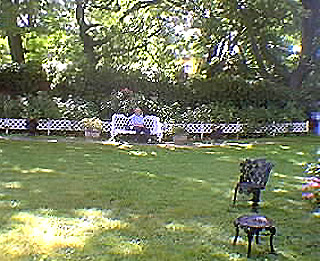 Another angle on the Lent Riker Smith Homestead rear garden looking directly across it toward the small trees and scrubs that block view of the Riker cemetery's eastern wall. Another angle on the Lent Riker Smith Homestead rear garden looking directly across it toward the small trees and scrubs that block view of the Riker cemetery's eastern wall.Photo by NYCHS during the June 5, 2005 tour given by Marion Smith to benefit the Queens Historical Society. Tour images do not appear in Edgar Alan Nutt's 2004 book and have been added to the web version by NYCHS. Click image to visit the Queens Historical Society web site.
|
|
[An undocumented source reports that the land that was leased to William
Hutchinson reverted to the West India Company for failure to cultivate; if this is correct
the property involved was other than the Poor Bowery farmstead.]
In addition to these
property transactions there is an undocumented report that Abraham Rycken in
1638 obtained the earliest deed for land in the town of Brooklyn.
From various court record entries, many of which refer to property
transactions, Abraham appears to have been rather quarrelsome and prone to
litigate. One such record involves the suit of Jacques Bentyn against Abraham
regarding stolen pigs that were eaten in Abrahamís house and the latterís
countersuit for slander. In April 10, 1642, proceedings resulted in proof being
presented that pork had indeed been eaten in his house as a result of which the
slander suit went nowhere,
The basis for the oldest and youngest sons in later Life to have adopted the Lent
surname is considered elsewhere. Some records include a daughter Wyntie who was
born in 1658 and married Hendrick Hendricksen, but it is certain that she instead was
the daughter of Ryck Hendrickszen and the sister of Hendrick Rycken who settled on
Staten Island; these individuals were members of the entirely separate Riker family
referred to in Chapter One.
The will was probated in Queens County on April 10, 1689, and
included an inventory of personalty totaling just £13.13.00 and consisting of his
clothing, two iron pots, two chests, some old iron, and four cows. Although the estate
seems extraordinarily small, its size is explained by the fact that realty, which
doubtless was very significant, was not at that time considered to be part of a
decedentís estate, and by the probability that son Abraham and family were living
in Abrahamís home and that much was already considered to belong to the son.
|

